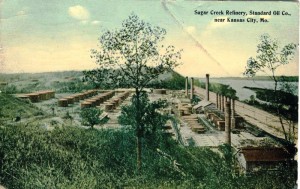By MICHAEL BUSHNELL
Northeast News
June 5, 2013
Just in time for Sugar Creek’s annual Slavic Festival this weekend, we bring you this postcard published by the Elite Postcard Company of Kansas City, Mo., entitled: “Sugar Creek Refinery, Standard Oil Co., near Kansas City, Mo.” The view on the card shows a view of the refinery looking west-northwest toward the Missouri River and Kansas City.
Located roughly eight miles east of downtown Kansas City, the land for the refining operation was acquired in 1903, purchased from the Mallinson family when their farm was subdivided for development. The rumor at the time was that the land was being purchased for a goat farming operation when in fact Standard Oil of Indiana wanted the land because of its central geographic location.
Refining operations began in 1904 and employees were re-located here from the oil company’s facility in Whiting, Ind. **The principal products of the refinery were kerosene that was sold from barrels in local grocery stores to light lamps and cook stoves in area homes.***
In the beginning, workers lived in tent cities scattered around the hillsides in Sugar Creek with two long sheds used as bunk houses and kitchens. Soon, modest homes replaced the tents and streets were laid out. In 1905, a bond issue was passed by a unanimous vote of all 47 residents of the newly christened town of Sugar Creek and a school was built, the archway of which is still visible along Sterling Avenue today. The name Sugar Creek was settled on after WWI when the city was officially chartered. The name Sugar Creek is derived from Indian lore, noting the small creek that flows through the rugged valley that was populated with sugar maple trees.
Sugar Creek’s annual Slavic Festival held in Mike Onka Park is a reunion of sorts for residents young and old to celebrate their eastern European heritage. Many of the refinery’s original employees hailed from Hungary, Czechoslovakia and Poland. Despite the fact that the refinery ceased operations in 1982, it’s still an important link in the petroleum industry, acting as a primary fuel depot for BP America.


















